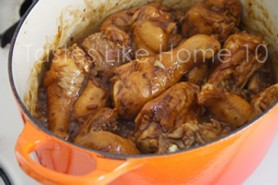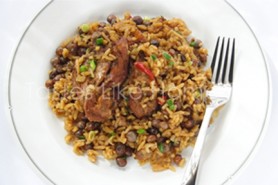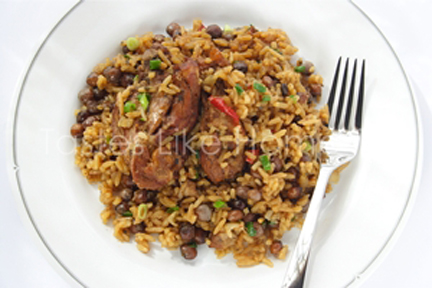Hi Everyone,
Ever since Guy Fieri, of Food Network Television visited Pam’s Kitchen in Seattle, Washington, on his Diners, Drive-ins and Dives show, I have been bombarded with questions and recipe requests for Trini Pelau – one of the main dishes featured.
 Pelau or Trini Pelau is a one-pot dish consisting of rice, a combination of meats or chicken along with pigeon peas that are all cooked with fresh coconut milk and aromatics such as herbs, onions and hot pepper. It is one of the go-to dishes whenever one thinks of liming (hanging out, a get-together, for my non-Caribbean readers). A big pot of Lau as the Trinis would fondly call the dish, is like no other – it has its own unique taste and flavour. And please don’t ever confuse it with Guyanese Cook-up Rice, if not we would have a regional one-pot-rice-dish war. While both dishes have a number of similar ingredients, their flavour profiles, appearance and compositions are not the same.
Pelau or Trini Pelau is a one-pot dish consisting of rice, a combination of meats or chicken along with pigeon peas that are all cooked with fresh coconut milk and aromatics such as herbs, onions and hot pepper. It is one of the go-to dishes whenever one thinks of liming (hanging out, a get-together, for my non-Caribbean readers). A big pot of Lau as the Trinis would fondly call the dish, is like no other – it has its own unique taste and flavour. And please don’t ever confuse it with Guyanese Cook-up Rice, if not we would have a regional one-pot-rice-dish war. While both dishes have a number of similar ingredients, their flavour profiles, appearance and compositions are not the same.
Making a Trini Pelau is an art, nevertheless, it is quite simple to prepare. The most difficult part of the dish is the burning of the sugar but you can substitute that with browning or even some cassava cassareep. I have to tell you though that the burnt sugar offers the dish its signature taste – this is what I think makes it singularly an exceptional Trini Pelau. Rather than just give you a recipe, I thought that I would take you through the making of the dish and explain each step of the process – what to expect and what should be happening. Ready? Here goes.
The equipment

A heavy bottomed pot with a cover is ideal but not absolutely necessary. A heavy-bottomed pot is desirable because the food is going to be cooking for a while and so using such a pot with cover will avoid burning and will also help to maintain the right temperature to ensure even cooking. Using a regular pot with cover is acceptable; you will just have to ensure that the heat is properly regulated and it may take a little longer for your Pelau to finish cooking as you constantly check to ensure that it is not scorching at the bottom.
Apart from the heavy-bottomed pot and cover, you’ll need a large spoon (pot spoon) and that’s it!
The ingredients
Pigeon peas – use either canned pigeon peas or rehydrated pigeon peas. If using canned pigeon peas, drain off the liquid. To rehydrate, soak the peas overnight. The rehydrated peas take a while to cook so I recommend cooking them fully or at least three-quarter way through before adding them to the pot. Save the cooking liquid to add the pot when cooking everything.
Meat & Chicken – you can make an all-beef, all-pork, all-lamb, all-goat, all-chicken or as my friend Felix says, one can make a “wild meat” Pelau. Wild meat would refer to labba, deer (venison) etc. Pelau can also be made with a combination of the meats; however, you want to ensure that the combination takes approximately the same time to cook. For example, if you are making a chicken and beef Pelau, clearly, the beef will need to be added to the pot first and be cooked for a certain time before the chicken is added.
Cooking liquids – coconut milk is a must have. Pelau is usually made with freshly squeezed milk; use canned or powdered coconut milk if you do not have access to the fresh variety. If you are using canned coconut milk, please dilute it; I find canned coconut milk to be too thick and always
recommend diluting it using 1:1.5 ratio (for every cup of coconut milk, add 1 and a half cups of room temperature water).

In addition to coconut milk, you will also need more cooking liquid and that can be stock, water, reserved cooking liquid from the peas, or a combination thereof.
Rice – parboiled rice is the recommended variety as it is hearty and really stands up to the long cooking. If you use regular long grain white rice, then you will have to adjust the amount of cooking liquid. I would suggest using quick cooking meats here such as chicken if you’re going to opt for regular long grain white rice.
Sugar – the excellent brown sugar native to the Caribbean is best but you can certainly use any brown sugar. If you have to, use granulated sugar.
Aromatics – onions, pimentos (also known as seasoning peppers), green onions, and whole hot peppers (scotch bonnets) are the order of the day. Don’t worry, the scotch bonnets are cooked whole so no bursting to fire up the Pelau (though some of us would not complain) Some people opt to put carrots in their Pelau, it is a matter or personal preference.
Other seasonings – once the meat (for the purpose of this column, I used chicken) is cut up, it needs to be seasoned with garlic, a mixture of fresh herbs, and various sauces and be left to marinate; an overnight marinate is excellent but a good hour or two will work. Of course salt and pepper to taste for the entire dish.
The method (Directions)
The key to executing this dish effectively is to ensure that all the necessary ingredients are prepped and ready for cooking. So don’t be trying to squeeze and measure the coconut milk while the chicken is cooking or chopping up the onions while the chicken and rice is sautéing. Have everything ready beforehand and close by.
Burning the sugar – start by heating some oil in the pot on medium high heat and once it is hot (not smoking) add in the sugar. Do not pour it in so that it becomes a mound; scatter it in so that it starts to brown evenly. If you pour it in and it becomes a mound, then the bottom will start to caramelize and the top will still be raw. As the sugar melts you will notice that it then begins to froth and bubble, as soon as you see this, it means the sugar has melted and it is caramelized, immediately add the chicken and stir to mix. I cannot overemphasize the need to have the seasoned chicken at hand because once the sugar reaches this stage of caramelisation there is a very small window before it starts to burn. The burnt sugar will turn black and become bitter and that bitterness would find its way into your Pelau! You do not want that to happen, so have the chicken at hand and ready.
Like I said before, I find this to be the trickiest part of the entire process of making a good Trini Pelau. Ready to go on?
Cooking the meat – once the meat or chicken has been added to the pot, stir to mix it thoroughly with the caramelized sugar. At this stage you want the meat/chicken to be thoroughly coated with the mixture and to infuse it. Let the meat/chicken cook for about 7 – 10 minutes
Adding the rice – I recommend washing your rice, this way, you will get rid of the excess starch and ensure that you have lovely whole fully cooked grains at the end of cooking. Once washed and drained thoroughly, add the rice to the chicken and stir to mix. What’s happening here is that the rice also being coated with the caramelized sugar and the flavours from seasoned meat/chicken. (If you’re familiar with Italian Risotto, this is similar to adding the rice to the softened onions at the onset of the dish). Let the rice and chicken cook together for about 3 minutes, turning it a couple of times.
Adding other ingredients – now is the time to add your cooked peas, onions, pimentos and carrots if using. Stir to mix and let cook for a minute.
Adding the liquids – pour in the coconut milk, the stock, reserved cooking liquid from the peas or water, whichever you are using. Season with salt and pepper to taste, add the whole pepper, stir everything to mix (the whole pepper should be floating at the top of the pot). Cover the lid and bring the pot to a boil.
Boiling and Simmering – when the pot comes to a boil, remove the lid partially to the side and let the pot continue to boil until you can see the surface of the dish (you will see the rice, peas and chicken clearly). At this stage, cover the pot completely, reduce the heat to low or simmer and let cook for 25 – 30 minutes or until all the liquid has evaporated. Stir in the sliced green onions and serve it hot or room temperature.
And there you have it; you’ve just cooked a pot of Trini Pelau. A Lau that is worthy of any lime or gathering!
Cynthia
tasteslikeome@gmail.com
www.tasteslikehome.org
Trini Pelau
Ingredients
3 pounds chicken cut up
2 tablespoons green seasoning
2 teaspoons finely grated garlic
1 tablespoon Worcestershire sauce
1 tablespoon soy sauce
1 tablespoon tomato ketchup
Salt and pepper to taste
2 tablespoons vegetable or canola oil
3 tablespoons brown sugar
2 cups parboiled rice, washed and drained
¾ cup chopped onions
½ cup chopped pimentos or sweet peppers
1 cup diced carrots (optional)
2 cups cooked pigeon peas
2 cups coconut milk
2 cups cooking liquid (stock, water or reserved cooking liquid from peas)
1 whole scotch bonnet pepper
Salt and pepper to taste
½ cup sliced green onions (white and green parts)
Equipment
1 bowl with cover
1 heavy-bottomed pot with cover
1 large spoon
Directions
1. Add chicken, green seasoning, garlic, Worcestershire sauce, soy sauce, ketchup to bowl along with salt and pepper to taste. Toss to mix thoroughly and set aside to marinate for at least one hour.
2. Add oil to pot and heat on medium high heat; when oil is hot (not smoking) sprinkle in sugar in an even layer. Let melt until the sugar starts to froth and bubble. Immediately add the chicken and stir to mix. Let cook for 7 – 10 minutes.
3. Add rice and stir to mix. Let cook for 3 minutes.
4. Add peas, peppers and carrots (if using); cook for 1 minute.
5. Pour in coconut milk and other cooking liquid; season with salt and pepper to taste, toss in whole pepper. Cover pot and bring to a boil.
6. When pot comes to a boil, remove lid partially and let boil until you can see the surface of the dish – rice, peas and chicken clearly. Cover pot fully, reduce heat to low or simmer and let cook for 25 – 30 minutes or until all the liquid has evaporated.
7. Sprinkle the green onions on top and fold into rice.
8. Serve hot or at room temperature.
Notes
● It is important to note the stage of the melted sugar for adding the chicken, if the melted sugar starts to turn black, then it is burnt and will have a bitter taste. If this happens. Start over the process.
● I used a whole chicken but you can opt to use thighs, drumsticks or a combination of both.
● Pelau can be made with any type of meat or rice but the cooking times would vary for the meats and so would the amount of cooking liquid for the rice.

